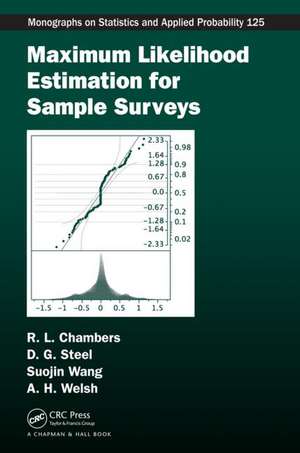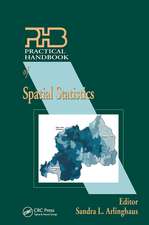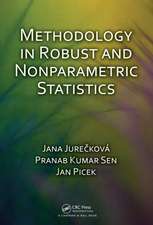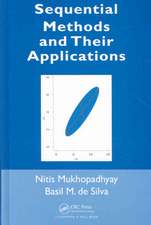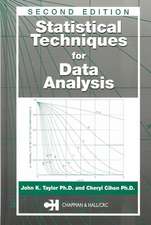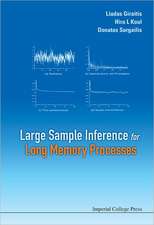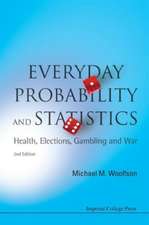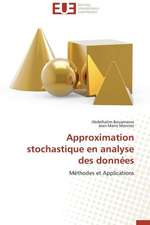Maximum Likelihood Estimation for Sample Surveys: Chapman & Hall/CRC Monographs on Statistics and Applied Probability
Autor Raymond L. Chambers, David G. Steel, Suojin Wang, Alan Welshen Limba Engleză Hardback – 2 mai 2012
Maximum Likelihood Estimation for Sample Surveys presents an overview of likelihood methods for the analysis of sample survey data that account for the selection methods used, and includes all necessary background material on likelihood inference. It covers a range of data types, including multilevel data, and is illustrated by many worked examples using tractable and widely used models. It also discusses more advanced topics, such as combining data, non-response, and informative sampling.
The book presents and develops a likelihood approach for fitting models to sample survey data. It explores and explains how the approach works in tractable though widely used models for which we can make considerable analytic progress. For less tractable models numerical methods are ultimately needed to compute the score and information functions and to compute the maximum likelihood estimates of the model parameters. For these models, the book shows what has to be done conceptually to develop analyses to the point that numerical methods can be applied.
Designed for statisticians who are interested in the general theory of statistics, Maximum Likelihood Estimation for Sample Surveys is also aimed at statisticians focused on fitting models to sample survey data, as well as researchers who study relationships among variables and whose sources of data include surveys.
Din seria Chapman & Hall/CRC Monographs on Statistics and Applied Probability
- 9%
 Preț: 731.84 lei
Preț: 731.84 lei - 9%
 Preț: 643.15 lei
Preț: 643.15 lei -
 Preț: 373.59 lei
Preț: 373.59 lei - 9%
 Preț: 1243.63 lei
Preț: 1243.63 lei - 9%
 Preț: 645.61 lei
Preț: 645.61 lei -
 Preț: 328.46 lei
Preț: 328.46 lei -
 Preț: 340.84 lei
Preț: 340.84 lei - 8%
 Preț: 396.91 lei
Preț: 396.91 lei -
 Preț: 347.50 lei
Preț: 347.50 lei - 9%
 Preț: 1040.74 lei
Preț: 1040.74 lei - 8%
 Preț: 397.49 lei
Preț: 397.49 lei - 9%
 Preț: 643.59 lei
Preț: 643.59 lei - 20%
 Preț: 689.56 lei
Preț: 689.56 lei - 18%
 Preț: 1111.90 lei
Preț: 1111.90 lei - 18%
 Preț: 1115.51 lei
Preț: 1115.51 lei - 9%
 Preț: 606.15 lei
Preț: 606.15 lei - 18%
 Preț: 1118.65 lei
Preț: 1118.65 lei - 18%
 Preț: 1118.99 lei
Preț: 1118.99 lei - 25%
 Preț: 526.38 lei
Preț: 526.38 lei - 25%
 Preț: 427.84 lei
Preț: 427.84 lei -
 Preț: 486.70 lei
Preț: 486.70 lei - 25%
 Preț: 499.81 lei
Preț: 499.81 lei - 15%
 Preț: 674.37 lei
Preț: 674.37 lei - 18%
 Preț: 1280.44 lei
Preț: 1280.44 lei - 23%
 Preț: 376.17 lei
Preț: 376.17 lei - 18%
 Preț: 1156.73 lei
Preț: 1156.73 lei - 18%
 Preț: 1326.99 lei
Preț: 1326.99 lei - 25%
 Preț: 487.34 lei
Preț: 487.34 lei - 28%
 Preț: 876.79 lei
Preț: 876.79 lei - 18%
 Preț: 703.79 lei
Preț: 703.79 lei - 27%
 Preț: 996.14 lei
Preț: 996.14 lei - 22%
 Preț: 413.08 lei
Preț: 413.08 lei - 25%
 Preț: 456.19 lei
Preț: 456.19 lei - 15%
 Preț: 489.26 lei
Preț: 489.26 lei - 18%
 Preț: 760.35 lei
Preț: 760.35 lei - 15%
 Preț: 718.62 lei
Preț: 718.62 lei - 28%
 Preț: 874.74 lei
Preț: 874.74 lei - 18%
 Preț: 919.10 lei
Preț: 919.10 lei - 28%
 Preț: 631.16 lei
Preț: 631.16 lei - 29%
 Preț: 627.88 lei
Preț: 627.88 lei - 27%
 Preț: 1000.51 lei
Preț: 1000.51 lei - 15%
 Preț: 671.64 lei
Preț: 671.64 lei - 15%
 Preț: 676.33 lei
Preț: 676.33 lei - 15%
 Preț: 489.26 lei
Preț: 489.26 lei - 28%
 Preț: 740.04 lei
Preț: 740.04 lei
Preț: 1117.07 lei
Preț vechi: 1362.29 lei
-18% Nou
Puncte Express: 1676
Preț estimativ în valută:
213.78€ • 232.13$ • 179.57£
213.78€ • 232.13$ • 179.57£
Carte tipărită la comandă
Livrare economică 22 aprilie-06 mai
Preluare comenzi: 021 569.72.76
Specificații
ISBN-13: 9781584886327
ISBN-10: 1584886323
Pagini: 391
Ilustrații: 10 b/w images and 36 tables
Dimensiuni: 156 x 234 x 25 mm
Greutate: 0.68 kg
Ediția:1
Editura: CRC Press
Colecția Chapman and Hall/CRC
Seria Chapman & Hall/CRC Monographs on Statistics and Applied Probability
ISBN-10: 1584886323
Pagini: 391
Ilustrații: 10 b/w images and 36 tables
Dimensiuni: 156 x 234 x 25 mm
Greutate: 0.68 kg
Ediția:1
Editura: CRC Press
Colecția Chapman and Hall/CRC
Seria Chapman & Hall/CRC Monographs on Statistics and Applied Probability
Public țintă
ProfessionalCuprins
Introduction. Maximum likelihood theory for sample surveys. Alternative likelihood-based methods for sample survey data. Populations with independent units. Regression models. Clustered populations. Informative nonresponse. Maximum likelihood in other complicated situations.
Recenzii
"This book makes a strong contribution to the model-based approach. … This book is the first thorough, self-contained development of the likelihood theory on sample survey data. … The authors demonstrate application of their maximum likelihood method in many important estimation problems. … the maximum likelihood approach presented in this book allows for further scientific discoveries and further new results when dealing with complex statistical data."
—Imbi Traat, International Statistical Review (2013), 81, 2
"The authors masterfully accomplish their goal and present us with an excellent and well-written book on model-based analysis for sample surveys. For the models with a mathematically tractable likelihood function, the authors develop the theory to the point ready for numerical implementation; for the mathematical intractable case, they also establish a conceptual procedure that allows future numerical research and implementation. … the book has something for just about every applied statistician and practitioner whose work is related to sampling survey design and analysis. … elegant presentation of the theory and clarity of writing make it easy to read. … a valuable theoretical contribution to the area of survey sampling and provides a thoughtful basis for further applied research. … I also recommend this book as a key reference for graduate students in applied statistics and related areas."
—Cheng Peng, Mathematical Reviews, May 2013
"This sinewy and satisfying book presents a thorough development of the use of likelihood techniques for the analysis of sample survey data, that is, for model-based analysis. … the authors have taken care to lace the presentation with generous explanations, drawing connections between the content and familiar examples in thoughtful ways, and occasionally providing guidance from their own experience. I particularly enjoyed the use of a stratified population to explain the difference between aggregated and disaggregated estimation. Here, and in similar places, the book shines. … well organized … [and] extremely well edited …"
—Andrew Robinson, Australian & New Zealand Journal of Statistics, 2013
—Imbi Traat, International Statistical Review (2013), 81, 2
"The authors masterfully accomplish their goal and present us with an excellent and well-written book on model-based analysis for sample surveys. For the models with a mathematically tractable likelihood function, the authors develop the theory to the point ready for numerical implementation; for the mathematical intractable case, they also establish a conceptual procedure that allows future numerical research and implementation. … the book has something for just about every applied statistician and practitioner whose work is related to sampling survey design and analysis. … elegant presentation of the theory and clarity of writing make it easy to read. … a valuable theoretical contribution to the area of survey sampling and provides a thoughtful basis for further applied research. … I also recommend this book as a key reference for graduate students in applied statistics and related areas."
—Cheng Peng, Mathematical Reviews, May 2013
"This sinewy and satisfying book presents a thorough development of the use of likelihood techniques for the analysis of sample survey data, that is, for model-based analysis. … the authors have taken care to lace the presentation with generous explanations, drawing connections between the content and familiar examples in thoughtful ways, and occasionally providing guidance from their own experience. I particularly enjoyed the use of a stratified population to explain the difference between aggregated and disaggregated estimation. Here, and in similar places, the book shines. … well organized … [and] extremely well edited …"
—Andrew Robinson, Australian & New Zealand Journal of Statistics, 2013
Notă biografică
Raymond L. Chambers, David G. Steel, Suojin Wang, Alan Welsh
Descriere
In recent years, likelihood methods are increasingly being used to analyze survey data in various disciplines, including the medical, biological, environmental, and social sciences. This book presents an overview of likelihood methods for the analysis of survey data obtained using methods that may result in the sample differing from the population, providing all necessary background material on likelihood inference. The book provides coverage of a range of data types, including multilevel data. Illustrated by numerous worked examples using tractable models, it also addresses advanced topics such as combining data, non-response, and informative sampling.
